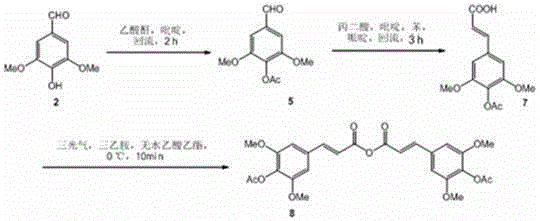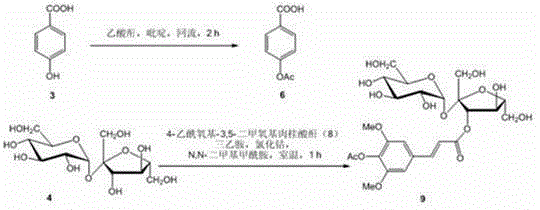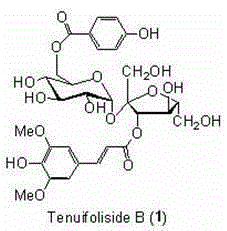A method for synthesizing tenuifoliside B
A technology of acetoxyl and sucrose, applied in the field of chemical synthesis of natural product TenuifolisideB, can solve the problem of no TenuifolidiseB chemistry, etc., and achieve the effects of cheap and controllable cost, few by-products, and high conversion rate
- Summary
- Abstract
- Description
- Claims
- Application Information
AI Technical Summary
Problems solved by technology
Method used
Image
Examples
Embodiment 1
[0024] 4-Acetoxy-3,5-dimethoxycinnamic acid ( 7 ) preparation:
[0025] Syringaldehyde ( 2 ) 60.06g (330mmol) was dissolved in 360mL pyridine, 36.72g (360mmol) of acetic anhydride was added, refluxed for 2 hours, cooled to room temperature, and directly put into the next reaction, adding 500mL of benzene, 52.00g (500mmol) of malonic acid, piperidine 5mL, install a reflux device with a water separator, oil bath, stir to dissolve, and reflux for 3 hours. After completion of the reaction, cool to room temperature, add 1000mL saturated sodium bicarbonate solution, stir, separate the water layer, acidify with 6mol / L hydrochloric acid to a pH value of about 5, filter, rinse the filter cake with 500ml water, and dry to obtain a white solid 4 -Acetoxy-3,5-dimethoxycinnamic acid ( 7 ) 56.18g, yield 64%. Melting point, spectral data, and high-resolution mass spectrometric data of 4-acetoxy-3,5-dimethoxycinnamic acid: melting point 202-204°C; =+0.2 (c=1.01, MeOH); 1 HNMR (500MHz, ...
Embodiment 2
[0027] 4-acetoxybenzoic acid ( 6 ) preparation:
[0028] p-Hydroxybenzoic acid ( 3 ) 4.55g (33mmol) was dissolved in 30mL pyridine, 3.67g (36mmol) of acetic anhydride was added, and refluxed for 2 hours. After completion of the reaction, cool to room temperature, add 100mL saturated sodium bicarbonate solution, stir, separate the water layer, acidify with 6mol / L hydrochloric acid to a pH value of about 2, filter, rinse the filter cake with 50ml water, and dry to obtain a white solid 4 -Acetoxybenzoic acid ( 6 ) 5.50g, the yield is 93%. Melting point, spectral data, and high-resolution mass spectrometry data of 4-acetoxybenzoic acid: melting point 191-193°C; 1 HNMR (500MHz, CD 3 OD): δ=8.06 (m, J =8.5, 2.5Hz, 2H), 7.21 (m, J =8.5, 2.5Hz, 2H), 2.29 (s, 3H) ppm; 13 CNMR (125MHz, CD 3 OD): δ=170.7, 169.1, 156.1, 132.4 (2C), 129.6, 123.0 (2C), 21.0ppm; HRMS (ESI): 181.0498 (calcd.forC 9 h 9 o 4 [M+H] + 181.0501).
Embodiment 3
[0030] 4-Acetoxy-3,5-dimethoxycinnamic anhydride ( 8 ):
[0031] 4-Acetoxy-3,5-dimethoxycinnamic acid ( 7 ) 31.92g (120mmol) was dissolved in 4000mL anhydrous ethyl acetate, 16.5mL (120mmol) of anhydrous triethylamine was added, cooled in an ice bath, 5.94g (20mmol) of triphosgene was added at 0°C under stirring, and the reaction was 10 minutes; react at room temperature for 20 minutes. Filter, wash the filter cake with anhydrous ethyl acetate (1000mL), combine the filtrate and washings, evaporate the solvent, and dry to obtain a white solid 4-acetoxy-3,5-dimethoxycinnamic anhydride ( 8 ), directly into the next reaction without purification, the yield is about 82%.
PUM
 Login to View More
Login to View More Abstract
Description
Claims
Application Information
 Login to View More
Login to View More - R&D
- Intellectual Property
- Life Sciences
- Materials
- Tech Scout
- Unparalleled Data Quality
- Higher Quality Content
- 60% Fewer Hallucinations
Browse by: Latest US Patents, China's latest patents, Technical Efficacy Thesaurus, Application Domain, Technology Topic, Popular Technical Reports.
© 2025 PatSnap. All rights reserved.Legal|Privacy policy|Modern Slavery Act Transparency Statement|Sitemap|About US| Contact US: help@patsnap.com



